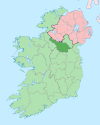- Dunmakeever
-
Dummakeever is a townland in the Parish of Kinawley, Barony of Tullyhaw, County Cavan, Ireland. The townland name is an anglicisation of the Gaelic placename “Dún Mhic Íomhair” which means ‘The Fort of Íomhair’s Son’. Íomhair, who lived about 850 A.D., was Lord of Tullyhaw and the son of Cosgrach mac Dúnghal. Íomhair’s son was Ruarc, after whom the townland is named, who lived about 880 A.D and was also Lord of Tullyhaw and an ancestor of the McGovern clan. Ruarc’s name is also preserved in the adjoining townland of Aghatirourke which is an anglicisation of ‘Achadh-tigh-Ruairc’ which means “The Field of Ruarc’s House”. These townland names, along with Moneensauran, supply important evidence that the McGovern clan originally came from Glangevlin and only later spread out to other parts of Tullyhaw such as Ballymagauran and Blacklion.The earliest surviving mention of the townland name is ‘Dunnemakevir’, from a list of Co. Cavan townlands printed in 1790. Dunmakeever is bounded on the north by Aghatirourke, Gortmaconnell, Legnabrocky, Aghnahoo, Tromogagh and Legg townlands, on the east by Bursan & Commas townlands, on the south by Tonanilt, Tullyminister and Corracleigh townlands and on the west by Tullycrafton, Ardvagh and Tullynacross townlands. Its chief geographical features are Cuilcagh Mountain reaching an altitude of 2,200 feet, Dunmakeever Lough, Dunmakeever Lough North, Owenmore River and several waterfalls.
Dunmakeever is traversed by the R200 main road from Ballinamore to Glangevlin and some minor lanes.
The townland covers an area of 1,233 statute acres. In the 1609 Plantation of Ulster, Dunmakeever formed part of lands which were granted to John Sandford Esq. by letters patent dated 7 July 1613 (Pat. 11 James I – LXXI – 38 ‘Glangewley’ & ‘Quilkagh’). It was later granted to Sir Toby Caulfield, Master of the Ordnance by letters patent of 12 July 1620 (Pat. 19 James I. XI. 45 ‘Glangewly’ & ‘Quilkagh’). Griffith's Valuation of 1857 lists fourteen occupiers in the townland.[1] In the 1901 census of Ireland, there are fourteen families listed in the townland.[2] In the 1911 census of Ireland, there are eighteen families listed in the townland.[3]
The only historic site in the townland is Carty’s Bridge which according to the website www.glangevlin.com- "derives its name from a window woman, Nellie Carthy, who had two sons. She owned a sheebeen and sold "poteen". She was reported to the revenue authorities in Enniskillen. The officers arrived on a Church Holiday. The congregation left the church before Mass was ended and sent word to Nellie that the officers were on the way. The people ran to her rescue and succeeded in hiding some of the "home brew". Some people got across the river Tamhnaigh while others followed pursued by the officers who were challenged and shots were fired. Two men, Doyle and McGovern were killed. Two large upright stones mark the spots where the men fell in the field, bordering the present Doonmakeever road and adjacent to the old Glan road"
References
External links
Places in County Cavan Towns Villages Agharaskilly • Aghavoher • Arvagh • Ballinagh (Bellananagh) • Ballyconnell • Ballyhaise • Ballymagauran • Ballymagovern • Bawnboy • Berrymount • Blacklion • Butlersbridge • Canningstown • Cavanagh • Cloncollow • Crossdoney • Cullyleenan • Derryginny • Dowra • Kilcogy • Killashandra • Kilnacreeva • Kilnaleck • Lisnahederna • Milltown • Mountnugent • Mullagh • Mullaghduff • Rakeelan • Redhills • Stradone • SwanlinbarLandforms Black Pig's Dyke • Dún na Rí Forest Park • Glengevlin • Lough Gowna • Lough Oughter • Lough Ramor • Lough Sillan • Magh Slécht • Shannon Cave • Shannon Pot • Slieve Cuilcagh • Slieve RushenCategory:Geography of County CavanCategories:- Townlands of County Cavan
- County Cavan geography stubs
Wikimedia Foundation. 2010.

